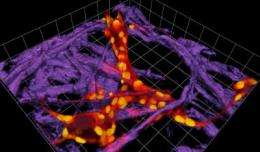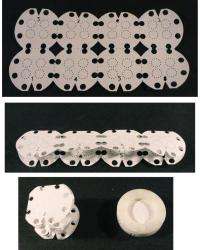The book of life can now literally be written on paper

(PhysOrg.com) -- An insight from the labs of Harvard chemist George Whitesides and cell biologist Don Ingber is likely to make a fundamental shift in how biologists grow and study cells - and it's as cheap and simple as reaching for a paper towel.
Ratmir Derda, a postdoctoral student co-mentored by Whitesides and Ingber at Harvard's new Wyss Institute for Biologically Inspired Engineering, has realized that by growing cells on several sheets of uncoated paper, he can solve a problem that has bedeviled biologists for years: how to easily grow and study cells that mimic the three-dimensionality of real tissue.
This work will simplify creation of realistic, three-dimensional models of normal or cancerous tissue -- potentially making it faster and easier to find drugs that fight cancer and other diseases.
"This research has the potential to become a standard laboratory tool, alongside the Petri dish, in laboratories that work with cells," said George M. Whitesides, the Woodford L. and Ann A. Flowers University Professor at Harvard University and a founding faculty member of the Wyss Institute. "Filter paper and other kinds of paper are readily available, and the technique is both very flexible in what it can do, and very convenient to use."
The study, "Paper-Supported Three-Dimensional Cell Culture for Tissue-Based Bioassays," appears in the October 19, 2009, issue of the Proceedings of the National Academy of Sciences.
Now, researchers grow cells in a Petri dish, creating a thin, two-dimensional layer of cells. If they want to do a better job of mimicking real tissue, they culture the cells in a gel. But because cells in different locations get vastly different amounts of oxygen and food, these cultures fail to mimic real tissues. And studying the cells from different parts of these gels without destroying the 3D culture is tricky.
By growing the cells in a thin layer of gel supported by paper, and then stacking those pieces of paper, the scientists showed they could recreate the benefits of two-dimensional research - where cells receive a uniform amount of oxygen and food -- while also closely mimicking real tissue. In this case, they engineered a 3D tumor on paper that exhibited behaviors similar to a cancer in the body.
Stacking multiple cell-containing sheets also allows researchers to examine the interior of a large cell cluster, either cultured on a dish or grown in vivo, simply by peeling the layers apart, without disturbing the properties of the cells. Isolating cells grown with other 3D culture techniques requires either performing complex laser-assisted surgery on the tumor sections or destroying the architecture of the tissue and then sorting the cells.

Derda said he had the initial insight that led to this study when he heard a colleague complain that he couldn't use paper to filter blood, because the erythrocytes, which give blood their red color, are sometimes trapped in the paper and sometimes go through it. Derda, who developed and used peptide arrays for stem cell research in his Ph.D. work, thought he might be able to use this trapping property for high-throughput screening. When he discussed that insight with Whitesides, the older chemist suggested Derda try stacking the pages instead.
Fellow postdoctoral student Anna Laromaine helped Derda figure out how to clip multiple layers of paper together while submerged in the gel, allowing the first multi-layer cell culture to grow. When he gingerly pulled the sheets of paper apart and analyzed the distribution of cells in different layers, he realized the versatility of paper as a growing medium and its potential to mimic any three-dimensional tissue.
"The best thing about this approach is that it can be used by everyone," Derda said. "Paper is nearly free, it's all over the place and you don't have to know anything other than how to dip."
Source: Harvard University (news : web)


















